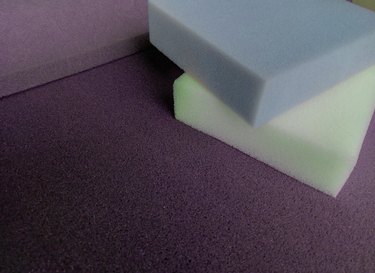
Most every painter has experienced the problems of bubbles in polyurethane finishes. It's not an uncommon problem, especially when applying polyurethane as the finishing coats. Theories abound over this topic – everything from the shaking of the cans that occurs during transport to the type of wood it's applied onto to impatience in applying poly by brush. However, there are several tried and true ways to apply polyurethane with success, according to the experts.
Choose the Appropriate Brush for the Job
Video of the Day
You need the right brush for the right job. If you just pick up any brush to apply polyurethane, you're asking for bubble trouble. For water-based polyurethane you want to use a nylon brush. For oil-based polyurethane you want a brush with a natural bristle.
Video of the Day
Soak the Brush Before You Use It
If you're applying water-based polyurethane, soak the brush in water first. If you're using oil-based poly, soak the brush in mineral spirits before using it. In either case, you'll see where one of the bubbling problems can begin – in the brush. After soaking the brush, you'll notice bubbles coming from under the ferrule (that's the metal part that holds the bristles to the handle, but you knew that). Soak the brush until the bubbling stops.
Remove the brush and lightly wring out the water or mineral spirits. Once the brush is primed, use it as you normally would. Remember, and this is important, slow your brush strokes. It's not like applying paint. Brushing too quickly invites air to become trapped in the bristles, creating air bubbles.
Try Using a Sealer
Whether or not the wood has been stained or otherwise colored, applying a coat of sanding sealer is often helpful. It lengthens the process, but once the wood is sealed you'll be applying the poly onto a smoother surface, reducing the surface aberrations and reducing the likelihood of creating bubble pockets as you go. Even though it is an extra step in the process, it will make the application of the polyurethane much easier, quicker and likely bubble free.
Thin the First Coat
Some professionals have reported very good results by thinning the polyurethane by as much as 25 percent for the first coat. Turpentine is the most common thinner. The concept behind thinning the first coat is to fill some of the unseen or unfelt pores in the sanded wood.
If polyurethane is thinned, it will seep into the undetected pores much easier than unthinned poly. If the wood has not been sufficiently sanded, it could show up as air bubbles in the polyurethane. The principle is similar to that of using a sealer before applying the polyurethane.
Remaining Bubbles in the Polyurethane
If you somehow still have a bubble in the polyurethane in the first coat, you can fix that by lightly wet sanding the areas. And lightly is the operative concept. If you use 400-grit sandpaper mounted on a sanding block, you should be able to remove any blemishes. Make sure to use enough water so you don't burn through the finish to bare wood. Also make sure you let the previous coat dry for at least 24 hours before sanding.